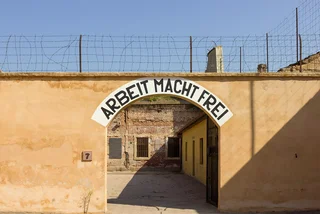To mark the 80th anniversary of the deportation of Jews from Bohemia and Moravia and the establishment of the ghetto at Terezín, several organizations have planned a joint program of events.
The first transport of Czech Jews left the Bubny railway station in Prague’s Holešovice district on Oct. 16, 1941, and the Terezín ghetto was established on Nov. 24, 1941.
One of the main events is an exhibition of photos by the late Pavel Dias called "Fragment – Memories for the Future" (Torzo – Vzpomínky pro budoucnost). It runs Oct. 13 to Nov. 28 at the House of the Black Madonna (Dům U Černé Matky Boží), near Old Town Square.

Dias, who passed away April 19, 2021, documented memorial events at ghettos and concentration camps for over 30 years. His photos not only capture the buildings but also document the fundamental change in the culture of remembrance over time. Dias’ grandfather was a Holocaust survivor. Dias, a native of Brno, was the first graduate of the photography program at FAMU.
There will also be conferences, discussions, lectures, concerts, exhibitions, and reverential meetings. The Memorial of Silence will hold its traditional happening against passive watching at the Bubny train station. The Eternal Hope festival will feature a gala concert by Israeli artists with poems by Ilse Weber and music by Viktor Ullmann in the Spanish Synagogue.
The Estates Theater on Nov.7 will present the opera “Brundibár,” staged by the ensemble of the Prague Children's Opera. The opera by composer Hans Krása was performed by children several times at Terezín, including for a visiting delegation from the Red Cross.

Weber, Ullmann, and Krása all were killed in Auschwitz after having first passed through Terezín. Coincidentally, the story of musicians and artists in Terezín is now being made into a film using authentic locations.
A program of music by Terezín composers Pavel Haas. Viktor Ullmann, and Gideon Klein will take place Oct. 24 at the State Opera.
Masaryk University will have an exhibition on the transport from Brno to Minsk. The Terezín Memorial will invite a former prisoner to the anniversary of the ghetto.
The program will end on Nov. 24, when a symbolic march with candles will take place from Bohušovice to Terezín in the footsteps of the first transport to the ghetto. The symbol of light will be transferred a few days later to the traditional Hanukkah holiday, when festive candles will be lit in many important places of memory. The first of them will be symbolically for the third time at the Bubny railway station.

Between Oct. 16 and Nov. 3, 1941, five transports left Prague to the ghetto in Łódž, Poland, and on Nov. 16, a transport went from Brno to the ghetto in Minsk, Belarus.
After that, the occupying German authorities decided that the Jews would be sent to a ghetto in the Protectorate of Bohemia and Moravia. The former military fortress town of Terezín was chosen.
PARTNER ARTICLE
The history of the Terezín ghetto began with the Aufbaukommando (AK-I), a group of 342 Jewish laborers who had construction experience. They began adaptations to Terezín on Nov. 24, 1941. The group had been told it was a temporary assignment and they would be allowed to return home after a few days, but instead they became the ghetto’s first inmates.
A total of 140,000 people arrived in Terezín in transports, and over 15,000 came in forced marches at the end of World War II. The largest group of deportees, more than 70,000, were Jews from Bohemia and Moravia.
Transports also came from Slovakia, Germany, Hungary, Austria, and Denmark. Many of the inmates were eventually sent to Auschwitz or other camps, where they were killed or died of disease. Only 23,000 of Terezín's inhabitants are thought to have survived to the end of the war.
Participants in the commemoration include the Monument of Silence, the Terezín Memorial, the Jewish Museum, the Terezín Initiative, the Federation of Jewish Communities, Masaryk University, the Arnošt Lustig Endowment Fund, the Holocaust Endowment Fund, the Opera of the National Theater, the Museum of Applied Arts in Prague, and Eternal Hope.












 Reading time: 3 minutes
Reading time: 3 minutes 



























